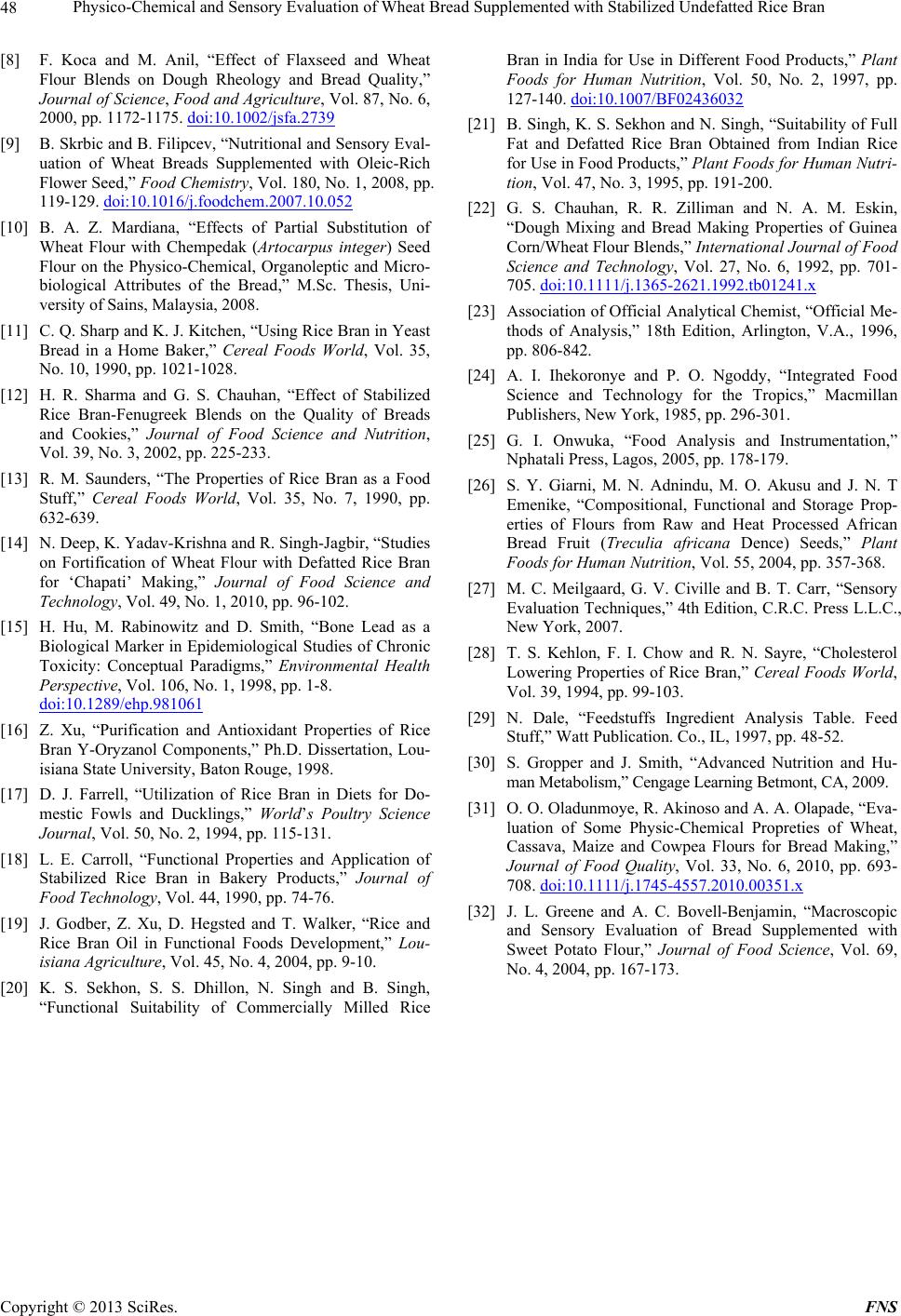
Physico-Chemical and Sensory Evaluation of Wheat Bread Supplemented with Stabilized Undefatted Rice Bran
48
[8] F. Koca and M. Anil, “Effect of Flaxseed and Wheat
Flour Blends on Dough Rheology and Bread Quality,”
Journal of Science, Food and Agriculture, Vol. 87, No. 6,
2000, pp. 1172-1175. doi:10.1002/jsfa.2739
[9] B. Skrbic and B. Filipcev, “Nutritional and Sensory Eval-
uation of Wheat Breads Supplemented with Oleic-Rich
Flower Seed,” Food Chemistry, Vol. 180, No. 1, 2008, pp.
119-129. doi:10.1016/j.foodchem.2007.10.052
[10] B. A. Z. Mardiana, “Effects of Partial Substitution of
Wheat Flour with Chempedak (Artocarpus integer) Seed
Flour on the Physico-Chemical, Organoleptic and Micro-
biological Attributes of the Bread,” M.Sc. Thesis, Uni-
versity of Sains, Malaysia, 2008.
[11] C. Q. Sharp and K. J. Kitchen, “Using Rice Bran in Yeast
Bread in a Home Baker,” Cereal Foods World, Vol. 35,
No. 10, 1990, pp. 1021-1028.
[12] H. R. Sharma and G. S. Chauhan, “Effect of Stabilized
Rice Bran-Fenugreek Blends on the Quality of Breads
and Cookies,” Journal of Food Science and Nutrition,
Vol. 39, No. 3, 2002, pp. 225-233.
[13] R. M. Saunders, “The Properties of Rice Bran as a Food
Stuff,” Cereal Foods World, Vol. 35, No. 7, 1990, pp.
632-639.
[14] N. Deep, K. Yadav-Krishna and R. Singh-Jagbir, “Studies
on Fortification of Wheat Flour with Defatted Rice Bran
for ‘Chapati’ Making,” Journal of Food Science and
Technology, Vol. 49, No. 1, 2010, pp. 96-102.
[15] H. Hu, M. Rabinowitz and D. Smith, “Bone Lead as a
Biological Marker in Epidemiological Studies of Chronic
Toxicity: Conceptual Paradigms,” Environmental Health
Perspective, Vol. 106, No. 1, 1998, pp. 1-8.
doi:10.1289/ehp.981061
[16] Z. Xu, “Purification and Antioxidant Properties of Rice
Bran Y-Oryzanol Components,” Ph.D. Dissertation, Lou-
isiana State University, Baton Rouge, 1998.
[17] D. J. Farrell, “Utilization of Rice Bran in Diets for Do-
mestic Fowls and Ducklings,” World’s Poultry Science
Journal, Vol. 50, No. 2, 1994, pp. 115-131.
[18] L. E. Carroll, “Functional Properties and Application of
Stabilized Rice Bran in Bakery Products,” Journal of
Food Technology, Vol. 44, 1990, pp. 74-76.
[19] J. Godber, Z. Xu, D. Hegsted and T. Walker, “Rice and
Rice Bran Oil in Functional Foods Development,” Lou-
isiana Agriculture, Vol. 45, No. 4, 2004, pp. 9-10.
[20] K. S. Sekhon, S. S. Dhillon, N. Singh and B. Singh,
“Functional Suitability of Commercially Milled Rice
Bran in India for Use in Different Food Products,” Plant
Foods for Human Nutrition, Vol. 50, No. 2, 1997, pp.
127-140. doi:10.1007/BF02436032
[21] B. Singh, K. S. Sekhon and N. Singh, “Suitability of Full
Fat and Defatted Rice Bran Obtained from Indian Rice
for Use in Food Products,” Plant Foods for Human Nutri-
tion, Vol. 47, No. 3, 1995, pp. 191-200.
[22] G. S. Chauhan, R. R. Zilliman and N. A. M. Eskin,
“Dough Mixing and Bread Making Properties of Guinea
Corn/Wheat Flour Blends,” International Journal of Food
Science and Technology, Vol. 27, No. 6, 1992, pp. 701-
705. doi:10.1111/j.1365-2621.1992.tb01241.x
[23] Association of Official Analytical Chemist, “Official Me-
thods of Analysis,” 18th Edition, Arlington, V.A., 1996,
pp. 806-842.
[24] A. I. Ihekoronye and P. O. Ngoddy, “Integrated Food
Science and Technology for the Tropics,” Macmillan
Publishers, New York, 1985, pp. 296-301.
[25] G. I. Onwuka, “Food Analysis and Instrumentation,”
Nphatali Press, Lagos, 2005, pp. 178-179.
[26] S. Y. Giarni, M. N. Adnindu, M. O. Akusu and J. N. T
Emenike, “Compositional, Functional and Storage Prop-
erties of Flours from Raw and Heat Processed African
Bread Fruit (Treculia africana Dence) Seeds,” Plant
Foods for Human Nutrition, Vol. 55, 2004, pp. 357-368.
[27] M. C. Meilgaard, G. V. Civille and B. T. Carr, “Sensory
Evaluation Techniques,” 4th Edition, C.R.C. Press L.L.C.,
New York, 2007.
[28] T. S. Kehlon, F. I. Chow and R. N. Sayre, “Cholesterol
Lowering Properties of Rice Bran,” Cereal Foods World,
Vol. 39, 1994, pp. 99-103.
[29] N. Dale, “Feedstuffs Ingredient Analysis Table. Feed
Stuff,” Watt Publication. Co., IL, 1997, pp. 48-52.
[30] S. Gropper and J. Smith, “Advanced Nutrition and Hu-
man Metabolism,” Cengage Learning Betmont, CA, 2009.
[31] O. O. Oladunmoye, R. Akinoso and A. A. Olapade, “Eva-
luation of Some Physic-Chemical Propreties of Wheat,
Cassava, Maize and Cowpea Flours for Bread Making,”
Journal of Food Quality, Vol. 33, No. 6, 2010, pp. 693-
708. doi:10.1111/j.1745-4557.2010.00351.x
[32] J. L. Greene and A. C. Bovell-Benjamin, “Macroscopic
and Sensory Evaluation of Bread Supplemented with
Sweet Potato Flour,” Journal of Food Science, Vol. 69,
No. 4, 2004, pp. 167-173.
Copyright © 2013 SciRes. FNS